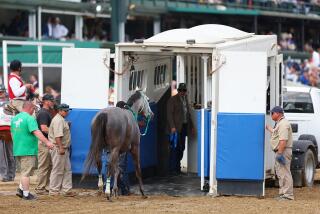Racing Form’s Improved Service--Less Data for Same Price
- Share via
WASHINGTON — The rulers of China have been called masters of doublespeak, but even they could take lessons from the Daily Racing Form.
For the past week the Form has been alerting the Washington-Baltimore area to expect a new tabloid format, which would “improve service to readers” and would offer a “concentration of coverage” of tracks in the region. When the first edition of the new Form appeared for Thursday’s races, local horseplayers learned what this “improvement” was: They would get much less information -- while still paying the same $2.50 per issue.
People who buy the Racing Form in Washington will no longer see past performances from Delaware Park or Atlantic City, among other tracks. They won’t get result charts from Philadelphia Park, Garden State, Monmouth Park and many other important tracks in the region. For horsemen and serious handicappers, this cutback is a nightmare. And even for casual fans, it is yet another manifestation of the Form’s unspoken credo: We’re a monopoly, so if you don’t like it, tough luck.
The change in the Form was triggered by media baron Rupert Murdock’s acquisition of Triangle Publications, which owned the Racing Form. The new management evidently saw no reason why the paper should be published in widely differing formats--as a full-sized paper in the East, a tabloid in the Midwest and West. “There was a general feeling in the ownership that it would be beneficial to standardize the paper throughout North America,” said general manager William H. Williams in Hightstown, N.J.
The tabloid Racing Forms in other parts of the country have inferior past performances, and the old guard in the Form’s management knew their readers would be ready to riot if this crucial information was abridged. “We wanted to get into the tabloid size without killing the PPs,” said editor Fred Grossman.
So the past performances appear in their familiar size and style, occupying three of four columns on a tabloid-sized page. The new paper is exactly half the size of the old format, and it’s easy to handle, easy to read. Esthetically, it is a definite improvement. But Friday’s edition of the tabloid was 64 pages, compared to 40 pages for a typical full-sized edition. In a game where every scrap of information is potentially crucial, this is a significant change for the worse.
Until the creation of this shrunken Racing Form, Washingtonians would get past performances for four or five tracks each day, and result charts for seven or eight. Now past performances and charts will be provided for only three tracks in the Baltimore-Washington edition -- usually Laurel, Belmont and Charles Town.
In other parts of the country -- California, for example -- the Racing Form could reasonably provide its readers with coverage of only two or three tracks. But horses in the mid-Atlantic region are routinely shipped among many different tracks. When Maryland horses go out of town, horsemen and horseplayers may want to see the competition they are running against; when out-of-towners come here, it’s helpful to have result charts from the out-of-town track to evaluate. We need more information-not 20% less.
The Washington-Baltimore area is the first to see the tabloid edition. “This is a test market,” Williams said. “We’re not trying to force this down people’s throats. We want to hear from people. We want them to tell us what they think.” (There is a questionnaire on page two of each day’s paper, and readers who can’t wait to voice their opinions may call the Form’s headquarters in Hightstown at 609-448-9100.)
Indeed, the edition sold in Washington was originally supposed to cover Penn National instead of Belmont Park, but the paper’s executives did quickly respond to suggestions that this was a ridiculous idea, so they may be sincere about wanting to hear suggestions. If so, here’s one.
If the Form doesn’t want to give us a 120-page tabloid each day to cover all the racing in the mid-Atlantic region, it ought to consider developing abridged formats for result charts and past performances for peripheral tracks. For places like Atlantic City and Penn National, publish smaller, half-column charts. Create a format of mini-past performances that would, say, show the last two races of each horse instead of the last 10. If an owner was shipping his horse from Laurel to Atlantic City, he could still see what kind of field he was running against. Racing fans need and want more information -- not Orwellian assurances that less is more.
More to Read
Go beyond the scoreboard
Get the latest on L.A.'s teams in the daily Sports Report newsletter.
You may occasionally receive promotional content from the Los Angeles Times.










